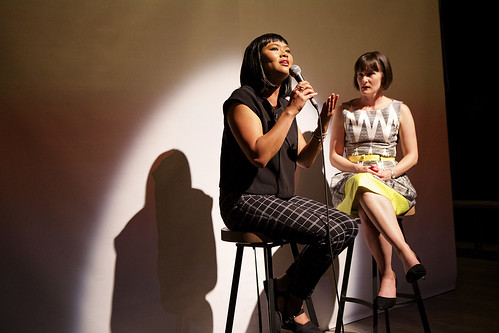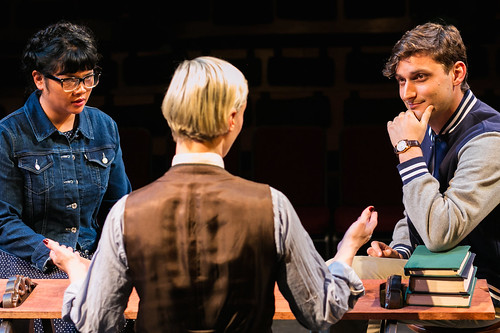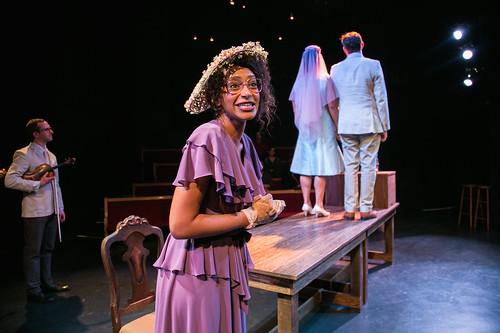
El Beh (left) and Elissa Beth Stebbins toy with the audience’s sense of reality in Christopher Chen’s Caught, a Shotgun Players production at the Ashby Stage. Below: Jomar Tagatac may not be the most trustworthy of narrators. Photos by Pak Han
Watching Christopher Chen’s new play Caught in its sublime Shotgun Players presentation is, in a word, disorienting, and that’s a good thing. Even clever theater-savvy folk who think they have it all figured out and are hip to what’s going on in this mind-twisting play will experience something new here, and it may not be apparent until they leave the theater. Your trust in what is real, what is true (a major theme of the play), will likely have shifted. The absurd things that happen to us on a regular basis and all the things we assume are true suddenly seem challenging and connected, as if we’ve stepped into a Chen play ourselves. The world has tipped slightly on its axis because of a play.
A serious examination of what is truth and what is fiction, Caught also deconstructs the theatrical experience itself to great effect. I’m not going to give anything away here except to say that this show (which is also enjoying an extended, sold-out run at New York’s The Play Company after productions all over the country) is something you should see, although tickets will be hard to come by. San Francisco-based Chen is fast emerging as one of the smartest, most inventive writers in American theater. If you saw his award-winning The Hundred Flowers Project in 2012 (read my review here), the way he uses China, Mao, theater and his outsize brain to dig into major themes may be somewhat familiar. But what he does with Caught takes things much further and blurs boundaries even more successfully.
Chen, working with director Susannah Martin, deftly crafts a 90ish-minute experience that keeps you guessing but never leaves you behind as it switches and swerves. There’s a further blur at work between the theatrical world and the visual art world, and that also helps keep things nicely off balance. It’s hard to talk about performances when you can’t always be sure performances are actually happening – at least in the traditional sense anyway – but Martin’s cast, which includes Jomar Tagatac, Elissa Stebbins, Mick Mize and El Beh/Michelle Talgarow (depending on which night you “experience” it), makes what could be a fuzzy evening all the clearer with their sharp, energetic work. It’s so interesting how we can sense when a person is speaking extemporaneously and when they’re performing, but for all the moving parts here to work optimally, we can’t always be entirely sure when the actors are acting or just talking.
It was clear when I saw the play Wednesday night at the Ashby Stage that certain audience members didn’t realize that certain things in play were actually part of the play, and that’s a huge tribute to the skill of the actors as they work to pass off reality as art and vice-versa (also a key component of the play itself).
Designers Nina Ball, Wesley Cabral, Christine Crook, Devon LaBelle, Ray Oppenheimer and Matt Stines seamlessly and beautifully blend the needs of a visual art installation (in collaboration with the Xiong Gallery) and a theatrical venture. It all ends up being a crucible for Chen’s heady mixture of drama and deep thought, which incorporates elements of postminimalist Lawrence Weiner and writers like Mike Daisey (The Agony and the Ecstasy of Steve Jobs) and James Frey (A Million Little Pieces), whose work has landed them in hot water when it didn’t remain resolutely in the lane of fiction or non-fiction.
There’s one section of the show involving concepts like “the box inside the outside of the box” and “breaking the authoritative borders of appropriation” that I need to hear/read again because I got lost (either by design or my thick head), but feeling all that brain power whizzing past you is also part of the play’s thrill. One thrill of many to be sure, some of which you probably won’t realize until Caught is long over. But then again, how can we be sure it’s ever really over?
FOR MORE INFORMATION
Christopher Chen’s Caught continues through Oct. 2 in its initial run and then through Nov. 26-Dec. 17 in repertory. Tickets are $25-$35. Call 510-841-6500 or visit www.shotgunplayers.org or www.xionggallery.org.



